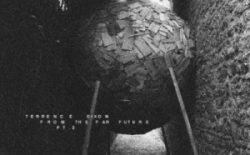Available on: Tresor LP
As a scuba diver embarks on their plunge they must adjust the internal pressure of their body to that of the waters surrounding them. This is done through an act called regulation; a patient downward journey split into short periods of sinking, pauses and adjustments to the ear canals, until the desired depth is achieved.
As an abstract reference, you could do worse than compare Terrence Dixon’s latest album, From The Far Future Pt. 2, to this experience. While not a linear journey by any means, there does seem to be some kind of narrative thread that weightlessly pulls the listener in all sorts of directions. Dixon is as Detroit as they come with his selection, easily compiling a cross section of sci-fi techno, Drexciyan submersion, futuristic jazz applications and classic, brittle electro touches, all while remaining entirely up to date in its production.
The CD release of From The Far Future Pt. 2 – a glorious, 14-track, 76-minute affair – immerses the listener from its opening track to the finale with barely any effort at all. Simplicity is key to this: timbrally the balance throughout is a classic light/dark affair, both between tracks and within them; instrumentation and material is limited to small groups; riffs are short, often 1 or 2 bars in length; production techniques to build a space are also used musically. It is an extremely focused record, but in such a relaxed manner that Dixon successfully manages to convey a wholly personal performance throughout. Like the best producers, you can hear ‘him’ as much as the music.
The beginning of the journey is therefore quite apt in being titled ‘Self Centred’. It eases the listener in with climbing, bouncing harmony and Afro/Latin percussion joined by Rhodes, a mixture of analogue warmth and synthetics that stays throughout the record. From the two-minute mark we begin to take the plunge into warm but dark waters, as rising and falling counter-harmonies and pitched percussion are punctuated by poignant jazz chords from Rhodes and sparse synth flute.
By its second track ‘Dark City Of Hope (Main Mix)’ we are already well on the way, a sustained, granular chord and a chugging, almost industrial beat creating a muted, dreamy factory atmosphere. ‘Fountains of Life’ could not be more different, delicately lead by a classic high-register space melody, somewhere between synthesized marimba and chimes. Slowly phasing in a 2-bar loop over a quiet calliope bass, ambiguity of phrasing is created through soaking it in delays, the drums almost a whisper in the background. 6 minutes in length, it isn’t until 3 minutes in that anything else joins, and this is only brief, sustained string lines, higher register metallic beeps and short flurries of hi-hat flickering.
‘My Journey Here’ suddenly pulls back into darkness, grainy hiss, crystalline pads and quiet, bubbling, thumping percussion driving us through loose, murky echoes. Paranoia then enters with ‘Path To Mystery’, the most ‘historically’ Detroit track on the album. A tight gathering of repetitive, frog-like filter gestures, brittle and discordant melody and sci-fi synth strings, it is the only inclusion that feels a little amateur in its lack of subtlety, but this is possibly through paying dues to a more basic, though no less important era of production.
‘The Switch’ is a remarkable surprise to follow, however, and any doubt is forgotten. Warmth comes flooding back in with Dixon’s idiosyncratic filter house, a 2-bar orchestral acid jazz loop warped and dramatically EQ’d in thick stereo as the track’s only content over a fast, barely-there shuffle. ‘Horizon’ then jumps in as another example of this reinvention, a pounding mixture of 909, mystical shakers and glassy high-register tones, paired with an almost bit-crushed Rhodes-like harmony strongly reminiscent of French house.
‘Vision Blurry’ uses similar techniques to ‘The Switch’ on sustained, muted jazz horns, pulled and re-pitched at the end of phrases as if on a turntable, a triplet hi-hat spinning beneath them. A simple kick-hat pulse, chugging bit-reduced bass and streams of octave bubbles soon usurp both parts, the rest of the track then simply passing back and forth between these two sets of material, blending their qualities.
After this three-track stretch of almost Romantic material, the vicious electro of the ‘The Auto Factory’, all Regis-like tribal percussion thundering, howling siren synths and classic handclaps, opens up a more furious part of From The Far Future Pt. 2. ‘Lead by Example’ and ‘Navigate’ follow, both relentless examples of acrobatic riffs on spiky synths and sustained pulses. The former chooses rave stabs as its main voice, building tension through long passages of single, 16th notes between very occasional, manic eruptions, while the latter takes a wildly spasming, heavily delayed acid line in odd phrasing around 909s and sustained strings.
‘Tone’ again switches the record’s direction. Maintaining the tension but dropping the volume, a subdued sine beep melody uses a classic acid technique – a cyclical riff that only aligns with the drums every 12 beats rather than 16 – to deeply hypnotic effect. ‘Blinking And Flashing’ then, as if realising it can improve upon the challenge, threads rapidly rising and falling acid and 8-bit bell riffs around fitful drum boxes, drenching them in spiralling delays to further heighten the confusion. By the time we reach album finale ‘The Study’ Dixon has made sure we are fully adrift in a cloud-like haze, a patient kick and hi-hat beat underpinning an undulating 1-bar melody, quiet plectrum-on-guitar-string-like tearing and fitful synth string pizzicato.
In From The Far Future Pt. 2 Terrence Dixon has constructed a record that neatly encapsulates a huge amount of the inspirational studio hardware experiments of historic Detroit techno, and in a manner that is so consistent in its results as to be deeply satisfying. As an album it also manages to be tantalisingly open-ended – a generous selection of compositions that hint at a much larger unknown.

































